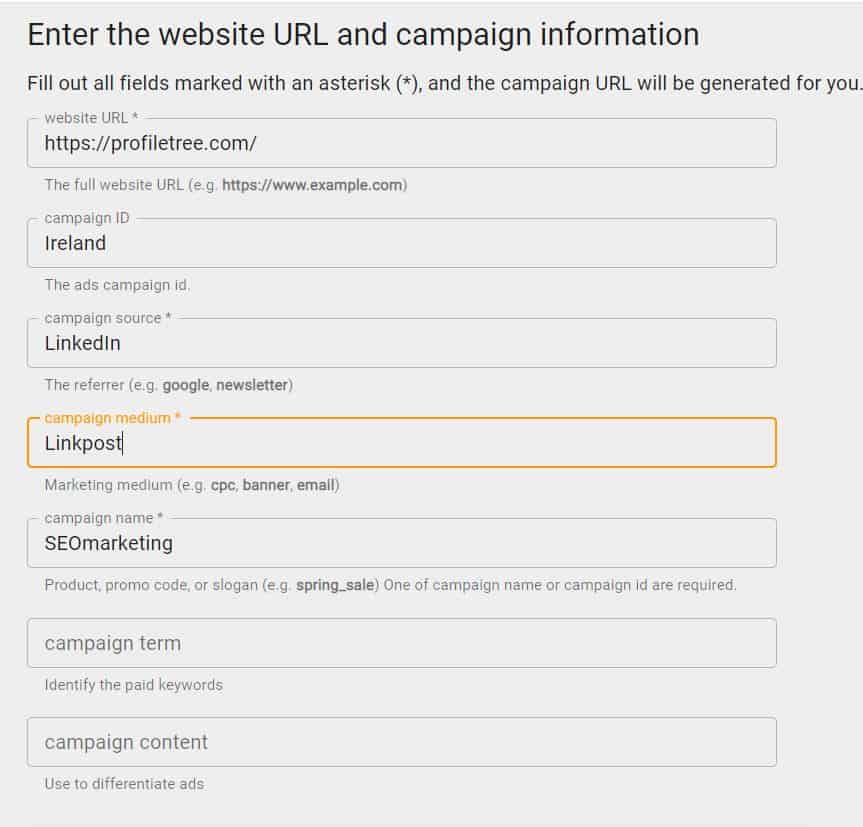Do you know that a reliable and efficient link tracking tool could be that missing tool that will level up your marketing strategy?
Yes, it’s.
While it’s pretty simple when used right, this tracking is a powerful tool that will take your marketing campaign to the next level. It will enlighten you about where your traffic comes from and, most importantly, which traffic source you should focus on more because it brings in the most paying customers.
Let’s picture this; you enter URL tracking or link tracking, which can be defined as a way to track what’s being clicked.
If it’s all new to you, link tracking is based on tracking the total number of clicks a link gains. Depending on your total, you can also access an abundance of other info that will enable you to understand your users better.
These insights are a wealth when it comes to analysing your target audience, and it helps you pick the right channel to reach out to your prospects.
To put it more directly, how will you know if your marketing activities are paying off without optimising a link tracking tool?
In this article, we will understand more about link tracking or a tracking URL, explain how a tracking link works, how to choose the best solutions, outline the benefits and uses of this technique, and discuss other tools you can check out.
Bonus: if you have yet to budget for one this month, keep reading, as some of them are FREE!
What is Link Tracking?
Link tracking is used to manage and measure the efficiency and effectiveness of marketing efforts, campaigns, and channels.
Marketers use a tracking link whenever they send traffic to a website or a landing page from an external source. And that’s you should do so.
These sources include banner ads, email, PPC campaigns, and social media.
In layman’s terms, link tracking is a regular URL equipped with tags added to the end. Otherwise known as parameters, these tags indicate where a user comes from, which campaign this content relates to, and what content they clicked through.
Businesses track links to assess marketing campaign success and uncover engagement statistics.
What is a Tracking Code?
Link tracking works by attaching a unique digital tracking code to a link on your site. The code on the link traces user activity (like clicks, for example) for that link only.
Each tracking URL is unique, so the data generated on each tracking link is only precise to that link. That’s when someone clicks through a tracking link; the information for that URL is stored separately than clicks on any non-tracking links.
How Does it Work?
As we said, tracking URL includes certain unique parameters with a digital code to a destination URL that tracks all user activity.
But which types of activities can be tracked? Read on:
- Impressions
- Clicks
- Average time on site
- Page views
- Click-through rates CTR
- Conversions
- Bounce rate
- New visitors
When you track a link, before a site user reaches the destination pages they wish to get, they’re temporarily redirected. Thus, that data like where they are located and which site visitors are coming from can be easily gathered.
This secret technique enables data to be collected and analysed.
Eventually, a URL tracker can be used through any online platform, including newsletters, email marketing, ads, social media posts, and blog posts.
Why Should You Use Link Tracking?
Imagine you’ve just created an email marketing campaign, built a landing page, or sent a newsletter to your subscribers.
You’ve spent time and money to create these marketing initiatives, which need easily accessible links to redirect your audience to a service or product.
To make your future interactions and communications successful, you must know what links are clicked.
Ask any marketer operating a large-scale marketing campaign across several channels, and they’ll tell you it’s a life-saver to know which content attracts the largest number of conversions.
By just adding a unique tracking code to each marketing action, you can pinpoint your most efficient activity or campaign down to the specific message or topic.
For Digital Marketing Agencies
It’s an entirely different ball game managing marketing campaigns in digital marketing agencies. Likely, you’re running and tracking ample campaigns for not one client but multiple at the same time.
For instance, you’re driving traffic to an electric store’s landing page with babber ads and PPC, targeting to generate leads for a B2B company’s email marketing, and promoting sponsored ads on a Linkedin page for another ecommerce web client.
It’s metrics mayhem! So many things you’re waiting to happen. And to observe numbers, you must keep an eye on many platforms at once.
Ironically, you’re not alone.
Based on a survey from Demand Gen Report, nearly 46% of marketers struggle with messy data.
They want to measure their campaigns to grab valuable data, but it seems hard without a tracking tool!
Using link tracking avoids metrics mayhem from the beginning as it’s based on link redirects. As a result, marketing agencies can kick messy data with a visual-based report with 100% accurate insights.
In other words, these URL parameters make it super easy to gather data, such as the conversion rate of each A/B testing ad or even the click-through rate (CTR) of each call to action (CTA) button in numerous email marketing campaigns.
For Marketers
Link tracking helps marketers to expand conversions as they can easily find which content fell flat and which took off. Then they can create a template with invaluable data.
Let’s say you wrote a bunch of product comparisons, how-tos guides and case studies for the company blog.
How on earth do you know which content drives the largest traffic or highest number of leads?
It’s straightforward; create unique URL links for these various posts’ CTAs and then track them accordingly.
What you will get determines your next content strategy.
For instance, if most of your prospects came from case studies or product comparisons, you may pause creating more guides and save your budget for the bottom of the funnel instead.
The result: you will be able to redistribute your resources.
For Affiliate Marketing
Suppose you’re a business owner who decides to rely more on affiliate marketing. In that case, It’s challenging to spot which affinities drive the biggest conversions to a landing page without link tracking.
By adding a unique tracking URL to each affiliate, brands can find out their most valuable sales-generating partners and choose which to work with for more extensive promotional campaigns.
Takeaway: link tracking shows the relationship between what you do and what you get. Tracking your marketing activities enables you to monitor how different effective types of marketing are for your company.
Important Tools for Link Tracking
Now, we’re going to show you the best tools for link tracking you can use to uncover specific social media traffic. That’s how you can get a better understanding of the effectiveness of your campaigns.
Google Campaign URL Builder (Free)
It’s a free and super link tracking tool that lets you automatically create URLs with UTM parameters. That’s how you can easily track those links’ performance in Google Analytics (GA). Google Campaign URL Builder uses UTMs tags added to the end of a URL and can be used to track any custom campaigns in GA.
Also, it’s easy to optimise.
To get started, go to Google Campaign URL Builder and set the parameters by filling out this simple form.
Here’s you can use this form:

Now, let’s break it down to know how to make it right:
- Website URL: the website address or landing page of the link you want to track.
- Campaign ID: the name is used to know which ads campaign this referral references. It’s not required.
- Campaign Source: Here, you should be specific about where you’re sharing your link— for example, Facebook, Instagram, LinkedIn, and so. Once set, this parameter will tell GA where the traffic is coming from. In the screenshot above, we’re adding LinkedIn as a source for our campaign.
- Campaign Medium: it tells Google Analytics which type of source or medium is driving traffic to your page. We’re talking here about the links you share on a channel, so this could be either paid ads like sponsored content on Facebook or a regular post. In this case, we are not promoting this link, so our medium is “linkpost.”
- Campaign name: Give a specific name to each social media link you’re willing to track so you can quickly identify them in GA.
- Campaign term: You can leave it empty if you’re running an ad. However, if you’re sharing a link on a channel, you can enter the unique keyword used to target the paid ad— for example: “T-shirts + men.”
- Campaign content: it’s a parameter mainly used for ads. For instance, if you have several ads leading to the same page, you can tailor a content tag to differentiate each campaign. This technique will enable you to see in Google Analytics which ads attract traffic to your website.
However, if you’re managing ads and you link your Google Analytics and Google AdWords accounts, Google will automatically add tags to your advertising campaigns.
Pro tip: If you are eager to tag the links you share on different social platforms quickly, there’s no quicker tool than using Chrome Extention for Google Analytics URL Builder. Just install the extension, and you’ll see its icon right next to the address bar on the top right side of your browser. This extension allows you to add tags to a link with a single click while you’re on a page. In addition, you’ll get the same tagging options in Campaign URL Builder without leaving the site you’re on.
Key features
- Link tracking
- Easy to use
- Totally free
Bitly (Free & Paid)
It’s an effective free marketing tool trusted by big brands like The New York Times, ESPN, Disney and more.
Yes, it’s a well-known tool to shorten links through its domain. In addition to link shortening, you can take advantage of its tracking feature to optimise your digital initiatives.
Also, it has a unified dashboard that lets you conveniently track your customers’ journeys on each platform. With the help of the real-time tracking and updating data it gathers and shares, you can really get to know your visitors much better.
This data will help you further create more relevant content for upcoming campaigns.
Moreover, you will get access to track engagement metrics on organic shares. That means you will identify links other Bitly users create to direct them to your content.
This brilliant tool has some premium features you’ll have to sign up for one of its pricing plans, such as using the custom domain name.
The paid packages start at only $8 monthly if you choose to be charged annually, making it a cost-effective tool with priceless data.
Otherwise, if you need to view the performance of links for more than 30 days, then you have to sign up for another package which will set you back $199 per month annually (but if you pick monthly billing, it jumps to $300 monthly)
Key features
- QR codes
- Insights and analytics
- Branded links
ClickMeter (Paid)
If you’re looking for an innovative URL generator, look no further than this one.
That will help you redirect users to a particular destination of your choice (let’s say British users to a British restaurant website) and even fight click fraud actions.
It’s one of the best link shorteners and is used by thousands of businesses of all sizes, including big names such as L’Oréal, iStockphoto, and Payoneer. This tool will help your team stay on top of their marketing activities and improve conversion rates.
Also, ClickMeter is an on-go single platform equipped with all insights you want to track. Your marketing members will keep their eyes on many metrics, such as clicks, views, and conversions. Plus, you can monitor broken links and customise their links.
Many marketers use it as an agency as it’s ideal for managing the marketing campaigns for your or your clients.
With that data, you’ll get better insights into how various marketing campaigns perform. Additionally, you can share the outcome with your team in real-time to take the right action if required.
Most importantly, you can use it for affiliates, as it will give you accurate data about clicks from real users and identify multiple clicks to gain the most accurate data.
Its packages start from $29 per month. But more advanced features such as white label reports and click fraud protection will cost you $99 per month to get exclusive access to Large Plan.
Key Features
- Vanity links
- Fraud protection
- Real-time reports
- Retargeting
- Split-test optimiser
Vlouum (Paid)
Just like other tools, this one will help streamline your affiliate campaign management. Using Vlouum, you can optimise, track, and automate your ad campaigns.
It doesn’t matter which digital marketing tool you prefer to display your ads; it works even for email marketing. This superb tool lets you track all forms of online ads. Plus, you can keep track of tons of metrics about visits and different clicks in real-time.
What’s more, it features a new option called Automizer. This one enables you to connect your Voluum account with your traffic sources by means of API.
But what makes this tool valuable is that you can use it to set auto-rules and active/pause your campaigns.
Let’s say you run an ad, and then you discover a keyword didn’t earn any conversions in the last 24 hours; the tool will give you access to create a criterion to pause this particular keyword.
Thus, you can choose to deactivate a whole campaign if you are unsatisfied with the result or if the ROI seems too low.
Creating alerts is also available to keep you informed about your links’ performance so that you will never be stuck behind your computer having no idea of what you should do.
It makes sense that this tool is expensive as opposed to other link-tracking options. Pricing starts at $89 monthly, but you can knock it down to $69 if you opt for a yearly plan.
Key features:
- Organic traffic tracking
- Fraud protection
- Real-time reporting
How Can Profiletree Help You?
With tracking links, you’ll be able to create a direct relationship between online and offline marketing activities and analyse online campaign results.
When executing an offline and online marketing campaign, you can add a tracking URL to your ad that is 100% unique to this specific marketing process.
For example, if you’re a supermarket publishing a magazine ad offering 30% off to new customers, you can optimise a URL like this:
http://www.yourstore.com/mag30
By creating this dedicated landing page for this offer, you can track how many people view and engage with this offline advertising campaign.
That’s how we can help you. It’s not just about creating a tracking URL and seeing the results. We will help you read and understand these insights to develop a data-driven strategy that will guide you to attain your business objectives smoothly.
Together, we will integrate this data with the marketing technologies of your website to create engaging content ready to publish on multiple platforms and run a successful campaign.
Ready to go and grow! Let’s talk.


